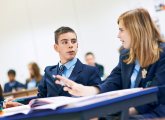‘Once upon a time’ to quote the finest traditional tales, there was a story. The audience listened to the story, engaging and absorbing every juicy detail as their brains reacted to the narrative structure. This might sound like fiction but there is evidence that we react differently when listening to stories. Our brain relaxes and we absorb more information because we approach the exercise of listening differently. We make the story real. We compare and internalise the information. Most importantly, we engage our creative brain, which opens up all sorts of opportunities for learning.
Throughout our lives, we use stories to connect with each other, whatever our age or background. We use them to build a common landscape and make sense of the world. Listen to the conversations around you. If you remove the stories you’re left with the lifeless delivery of information. The narrative structure enhances the way we communicate, so it makes sense to use it as a teaching tool, and one that can be applied to any area of the curriculum.
Stories are not just for English, they’re for life! Even the most scientific subjects can be made vividly memorable by the clever use of an interactive tale. There are three main story groups (traditional, memory and springboard), each with benefits depending on the message you want to get across and the age of your students. For example, springboard tales are ideal for presenting difficult concepts such as statistical equations, or theories which students might otherwise struggle with. This is because these tales are interactive, and involve input from the audience, so they can be used to promote discussion and learning from KS2 and beyond. Traditional tales – such as fairy or folk stories – might seem childish, but they have a place too, if you’re prepared to be flexible and explore different viewpoints, or use them as a way to introduce a topic. And memory tales work at any age because we draw comparisons with the teller and share in his or her experience.
1. Going Traditional
Covering the vast umbrella that is fables, folk and fairy tales (or wonder tales as the Victorian’s aptly called them) traditional stories are a storytelling staple. The meaning is evident, making them a great introduction to many subject areas.
Take the ‘three little pigs’. This seems like a simple tale of good versus evil, the hungry wolf pitted against its bacon. But the core truth of the story is one of learning, perseverance and dotting the i’s and t’s. As one academic said, ‘I can use this to highlight the importance of rules and regulations when entering the world of social care.’ Through her eyes, the three little pigs could be used to teach a valuable lesson. The first little pig can’t be bothered to make his home secure, so he cuts corners, and uses straw. The wolf huffs, puffs, and blows his house down, leaving the pig vulnerable and exposed. The second little pig isn’t quite as rash – but he still wants to save time, so instead he uses twigs. It takes a bit more effort, but again, the wolf is able to blow the house down, leaving its occupier defenceless. The third little pig, reflecting upon his previous colleagues’ efforts, decides he’ll put everything in place, no matter how time consuming the process. He builds his house out of bricks, and hey presto, the wolf cannot get in. More importantly the pig is left in a position of power to deal with him!
Traditional tales can be effective tools in the delivery of clear and concise information. Something as simple as changing the perspective by telling the story from a different viewpoint, or starting at a different stage in the narrative, can enhance and even change the meaning, depending on your needs.
2. Memories are made of this…
Based on personal experience, memory tales are easy to adapt for use in teaching. They’re also available in abundance, as we have hundreds of experiences every day! When we tell a memory tale, we allow our audience to identify with what we’re saying. During the telling of the story they may develop an internal dialogue, which says ‘if so and so did that and it worked for him, then maybe it will work for me.’ We challenge and compare notes as the teller continues his narrative and we learn by sharing in the experience. So a simple tale about the trials and tribulations of buying a birthday present on a budget, becomes a lesson in fractions and multiplication, for example.
Of course it’s not always easy to turn an experience into a story. Simplify the structure initially by splitting the experience into three parts: beginning, middle and end. Imagine three boxes, and fill them with bullet points for each stage in the narrative. Then picture a bridge between each box, and think of a phrase or sentence that will move the story along to the next stage. Think of one word which sums up the key message of the story. Now give this skeletal structure some flesh. Consider your first sentence. Remember that this must engage your audience, drawing them in and giving a hint of what they’re about to receive. Finally consider how you’ll end the story. Think about the word you picked for your key message, and use language that will conjure up this word. Use your final sentence to reinforce the message.
3. Take a leap
Springboard tales are the most accessible and applicable because they’re easy to create and adapt. These sneaky stories have an ulterior motive! By making them interactive, we can encourage learning through experience, whilst listening and creating a narrative.
In springboard tales, as in most stories, we reach a point of crisis. This is the point where the story can go in any direction. It doesn’t have to be an actual ‘crisis’ but it may be a dilemma or a problem that needs to be resolved. At this stage we can make the tale interactive and ask our audience to figure out what happens next. By continuing the narrative thread, they learn about the themes within the story, and the process of creation promotes discussion. For example take a tale about girl who plays hockey at school, and stands up to the class bully during a game. She says ‘you’re not the best hockey player in the school and I’m going to prove it!’ This can then become an informative session on the use and benefits of data handling. The point of crisis is the girl standing up to the bully. When this happens, the class are split into groups and asked to write the end of the tale. To do this they need to consider how the girl will prove the bully wrong? What sort of evidence does she need? How will she collect this evidence? And how will she present it clearly? They might illustrate this using a storyboard and diagrams. By doing this they learn about data handling, and use statistical vocabulary whilst stretching the imagination. The activity promotes discussion, and with the right questions, the students can be steered to a satisfactory conclusion.
Any story can be transformed into a springboard tale with some tweaking, but it’s just as easy to create your own model using a step-by-step approach. Start by considering your audience; who are they and what do you want them to learn? Work through each point in the following list and map out your tale:
Setting.
Choose a place that your audience can identify with. So you might not pick a court of law (unless you had a group of lawyers in front of you) but you might select a school classroom or a skate park. Characters. Again choose characters your students can identify with, so peers of roughly the same age.
Experiences.
To form the body of the story, think about experiences that your audience have been through and recognise and apply them to the characters and setting. So in the data-handling tale, the girl plays sport, something that happens in every school. She encounters a bully, again a common experience in education.
Point of Crisis.
Ask the following question – what do you want your audience to learn? Apply this to the experience by putting the characters in a situation where they have to learn the same thing.
Conclusion.
Although you’re going to make the tale interactive, you still need to know where it’s headed, and the resolution you want your students to reach. By working this out, you can then use questions to steer them in the right direction, whilst also leaving plenty of room for discussion and discovery.
Engage, excite, enhance!
Whatever the age of your students, don’t be afraid to have fun and explore different avenues of creativity. Get interactive and use stories – from any of the three main categories – to set the scene for some role-play, or to provide the background to a class challenge or competition. Turn the tables on your pupils and ask them to create a tale to explain a particular concept. Build a narrative structure together, and use it to help your learners engage with new ideas. Fire the imagination with some storytelling, in other words, and you’ll also light the way to a brighter understanding.
About the expert
Alison L R Davies is an author, columnist and professional storyteller. She works in schools, libraries and universities running storytelling sessions and workshops on the effective use of language to deliver new concepts, and how to use the narrative structure to enhance teaching and learning. She is the author of ‘storytelling in the classroom’ published by sage, ‘read me a story’ published by Bloomsbury, and the dark fantasy novel for teens with reading difficulties, ‘the after school club’ published by Barrington Stoke. Her latest book aimed at early years practitioners is due for publication by Routledge, later this year. For more info on her work contact alrdavies.writer@hotmail.co.uk










